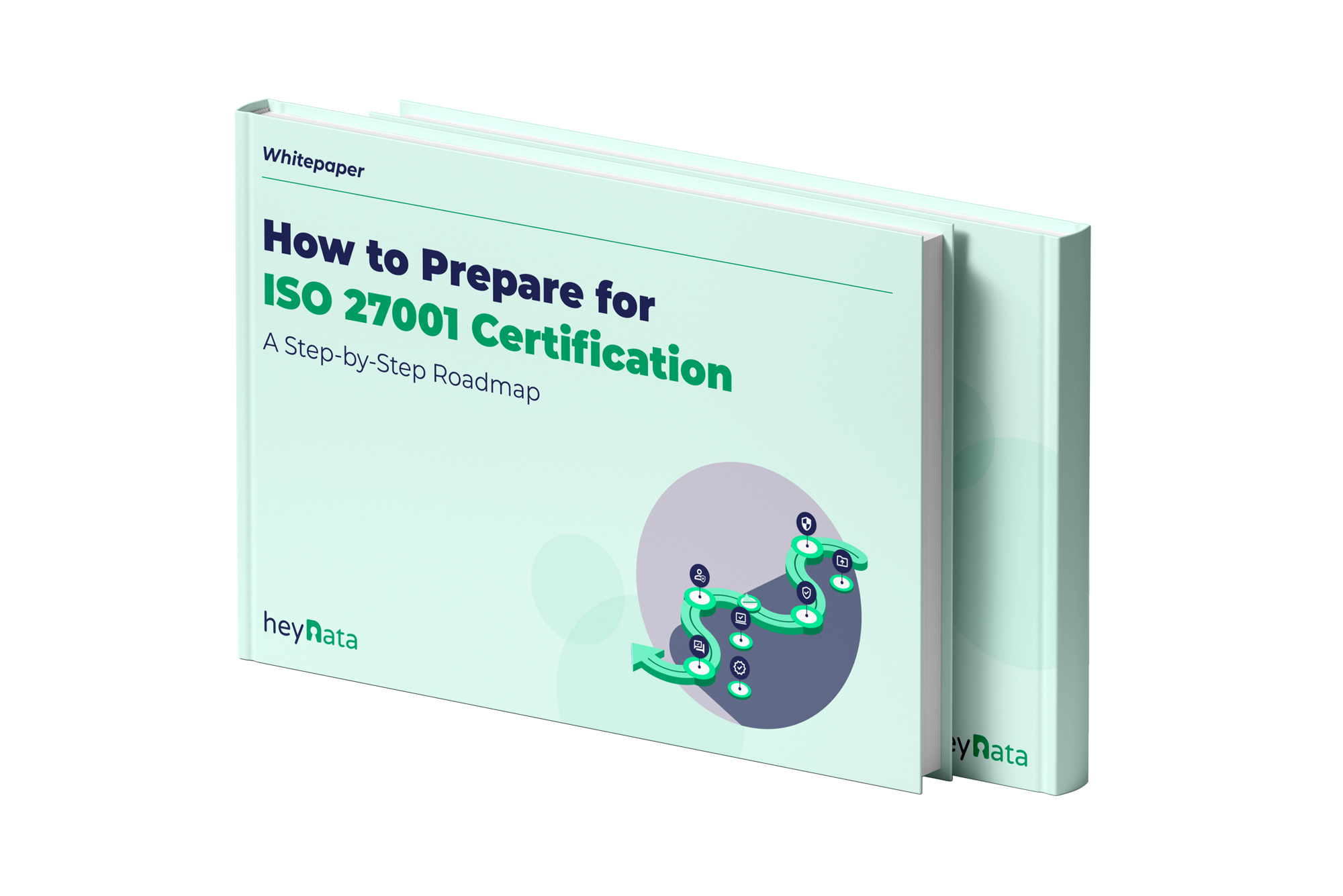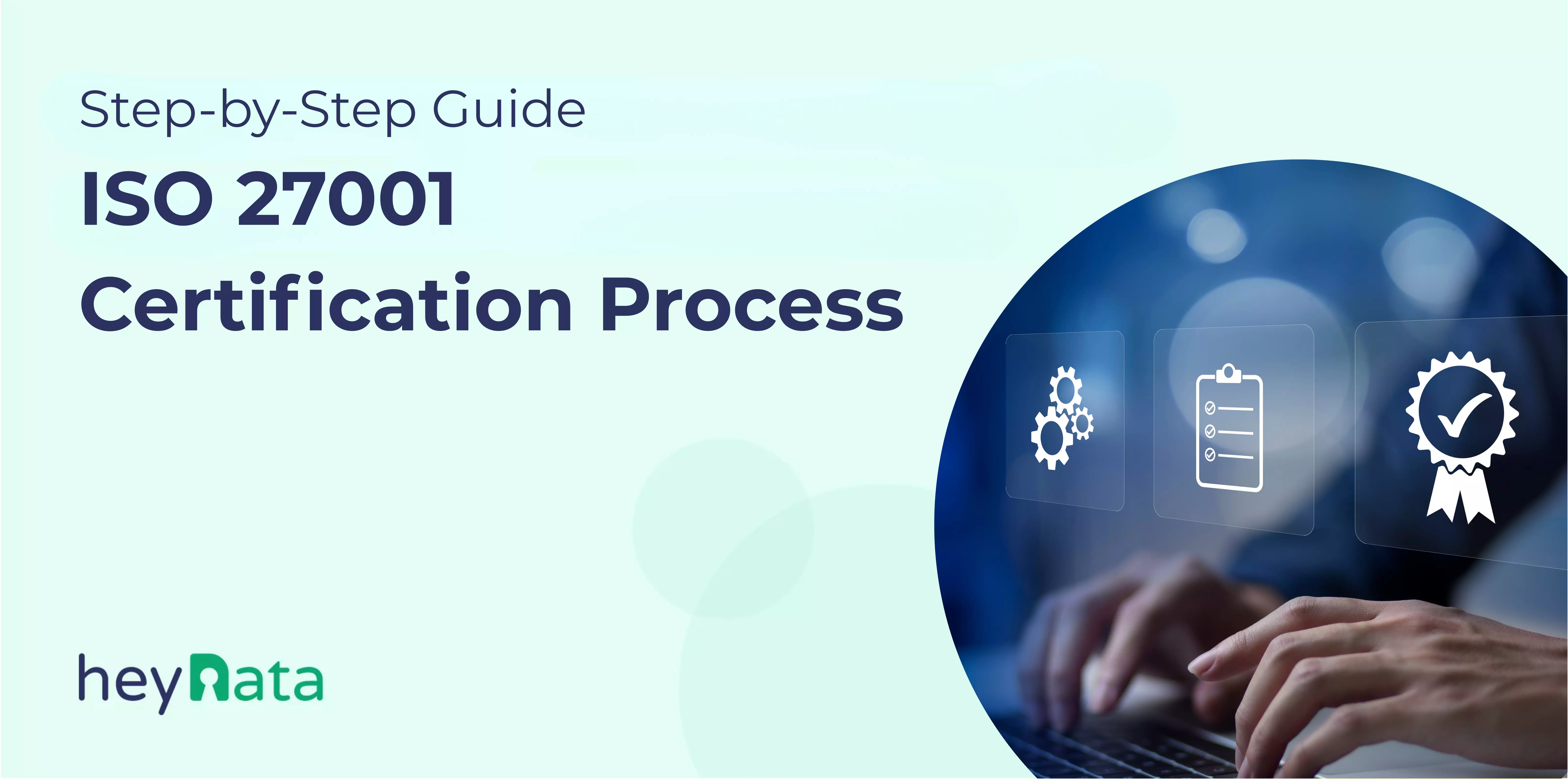
ISO 27001 Process Checklist
The ultimate checklist for your team – all 5 phases at a glance, including tasks, responsibilities, and more.

ISO 27001 Certification Process – A Step-by-Step Guide

'%3e%3cpath%20d='M26.6667%2020.022L30%2023.3553V26.6886H21.6667V36.6886L20%2038.3553L18.3333%2036.6886V26.6886H10V23.3553L13.3333%2020.022V8.35531H11.6667V5.02197H28.3333V8.35531H26.6667V20.022Z'%20fill='%230AA971'/%3e%3c/g%3e%3c/svg%3e) Key findings:
Key findings:
- ISO 27001 certification involves five phases, from gap analysis to recertification over a three-year period.
- A clearly defined scope and complete ISMS documentation are mandatory for a successful audit.
- Internal audits and management reviews provide targeted preparation for the external certification audit.
- Typical mistakes such as unclear responsibilities and a lack of training jeopardize success.
- With heyData, certification is faster and easier thanks to templates, automation, and personal support.
ISO 27001 certification is the global gold standard for information security. For SMEs, startups, and SaaS providers, it’s becoming essential to build trust, ensure compliance, and partner with larger organizations.
But how exactly does the ISO 27001 certification process work? What steps are involved, and how can you avoid common mistakes? In this guide, we walk you through the ISO 27001 certification journey – clear, practical, and up-to-date with ISO/IEC 27001:2022.
Good to know: This guide is especially helpful for businesses with no prior ISO experience.
Table of Contents:
What is ISO 27001?
ISO 27001 is an internationally recognized standard for Information Security Management Systems (ISMS). It defines how companies protect data in a structured way, manage risks, and continuously improve their security posture.
Getting certified by an accredited body – such as TÜV, DEKRA, or BSI Group – demonstrates your commitment to professional information security and boosts your competitiveness.
Who Would Benefit From ISO 27001 Certification?
- SMEs handling sensitive customer data
- SaaS companies operating cloud-based services
- Startups looking to partner with enterprise clients
- Any organization aiming to visibly showcase trust and professionalism
ISO 27001 Certification Process: 5 Key Steps
1. Gap Analysis & Project Planning
Before you launch your ISMS project, conduct a gap analysis to assess what requirements you already meet and where there’s room for improvement.
To-dos:
- Assemble and assign your ISMS project team
- Define the timeline, budget, and project structure
- Perform a thorough gap analysis
- Define the scope of your ISMS: which business areas, IT systems, and locations are included? This is a critical element and will be audited.
- Get management on board: Executive support must be active and visible.
Tip: Think of the scope like a security perimeter around what’s being certified. It must be clearly defined and will be checked during the audit.
2. Build & Document the ISMS
Now it’s time to roll up your sleeves. You’ll define processes, create policies, assign responsibilities, and thoroughly document everything.
Put simply: you're creating a security handbook for your company – including policies, emergency plans, and risk assessments.
Key documents include:
- Security policy, roles & responsibilities
- Risk Assessment & Risk Treatment Plan
- Statement of Applicability (SoA)
- Business continuity plans & training frameworks
The SoA outlines all relevant security controls and explains why they are (or aren't) implemented.
The Risk Treatment Plan outlines how you manage identified risks: by avoiding, reducing, accepting, or transferring them.
3. Internal Audits & Management Review
This is your internal test run. The goal is to verify that your security processes work in practice, not just on paper.
What’s included:
- Internal audit in line with ISO 27001
- Management review of the current security posture, with clear recommendations
- Address and document weaknesses
- Introduce performance indicators (KPIs), e.g. % of employees trained or time to report incidents
4. External Certification Audit (by an accredited body)
This is the official audit, conducted by an independent certification body (e.g. TÜV or BSI Group).
Stage 1 Audit:
- Review of your documentation to ensure completeness
- No implementation check yet – this is essentially a document audit
Stage 2 Audit:
- On-site audit including interviews, process observations, and system checks
- Demonstrate that your ISMS works in practice
- Employees should be aware of their security responsibilities
At the end, you'll receive an audit report – and ideally, your ISO 27001 certificate.
5. Ongoing Maintenance & Recertification
The ISO 27001 certificate is valid for three years, with annual surveillance audits in between.
Ongoing requirements:
- Keep your ISMS updated and continuously improve it
- Conduct regular internal audits and staff training
- Account for new risks, technologies, or regulatory requirements
- Use the PDCA cycle: Plan – Do – Check – Act
Pro tip: Schedule regular touchpoints early – such as for risk reviews or awareness training – to stay on track.
How Long Does ISO 27001 Certification Take – and What Does It Cost?
That depends on the size of your company and how much has already been prepared:
Timelines:
- Small companies: typically 3–6 months
- Mid-sized companies: typically 6–9 months
Costs:
- Internal resources: time and staffing
- External consulting: optional, but often highly recommended
- Certification costs: vary by provider and company size (typically €5,000 – €25,000)
Common Pitfalls – and How to Avoid Them
- Unclear responsibilities within the project team
- Incomplete or overly technical documentation
- No or superficial staff training
- ISMS is not integrated into daily operations
- Missing or poorly defined scope
- No Statement of Applicability (SoA) created
Our tip: Start internal audits early and bring in professionals like heyData to support you throughout the process.

ISO 27001 Process Checklist
The ultimate checklist for your team – all 5 phases at a glance, including tasks, responsibilities, and more.
Why heyData is the Right Partner for Your ISO 27001 Journey
With heyData, you don’t just get software – you get a full-service compliance solution:
- Ready-to-use templates for ISMS, SoA & audits
- Automated risk assessments
- GDPR, ISO 27001, NIS2 & EU AI Act all in one platform
- Personal guidance from real compliance professionals
ISO 27001 FAQs
How long does ISO 27001 certification take?
Typically between 3 and 9 months, depending on your current readiness.
What does it cost?
Generally between €5,000 and €25,000 – depending on company size and scope.
What documentation is required?
Security policies, risk assessments, emergency plans, training records, Statement of Applicability, and more.
What’s the difference between internal and external audits?
Internal audits help you prepare. External audits are conducted by accredited bodies during a two-stage certification process.
What is the SoA (Statement of Applicability)?
A mandatory ISO 27001 document listing all applicable security controls and explaining why they are implemented or not.
Do I need an external consultant?
Not mandatory, but highly recommended – especially for first-timers. A partner like heyData can save you time, stress, and mistakes.
What exactly is an ISMS?
An Information Security Management System (ISMS) is your company’s roadmap for handling digital risks – covering everything from policies and processes to technologies.
Conclusion
ISO 27001 certification is more than a security seal – it proves your commitment to information security, trust, and operational excellence. With a clear plan, the right tools, and expert support, your organization can achieve certification smoothly – and gain a competitive edge.
The certification opens doors to new clients who require ISO 27001 as a prerequisite for collaboration.
heyData is by your side every step of the way – from planning to recertification.
Important: The content of this article is for informational purposes only and does not constitute legal advice. The information provided here is no substitute for personalized legal advice from a data protection officer or an attorney. We do not guarantee that the information provided is up to date, complete, or accurate. Any actions taken on the basis of the information contained in this article are at your own risk. We recommend that you always consult a data protection officer or an attorney with any legal questions or problems.



